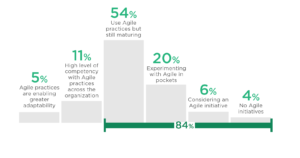
Benefits of Agile
The top benefits of adopting Agile in this report are fairly consistent with recent years. The respondents stated by using Agile approaches, they’ve seen greater ability to manage changing priorities, increased project visibility, higher alignment between IT and the business, faster delivery speed/time to market, and increased team morale. These benefits align nicely with the reasons the respondents indicated when asked why they wanted to adopt Agile–acceleration of software delivery, enhancing the ability to manage changing priorities, increasing productivity, and improving alignment between IT and business.
Digging Deeper into Some Stats
A few statistics stood out, which could highlight some potential areas of opportunity, including:
- 51% of respondents said either all their teams or more than half of their teams use Agile. While there is significant usage in half of the organizations in the survey, the other half could have a way to go for adoption.
- 84% of respondents stated they were “below a high level of competency” with Agile practices (consisting of 54% stating they use some Agile practices but are still maturing, 20% experimenting with Agile, and 10% of either considering Agile or no Agile initiatives). There appears to be opportunities to mature practices at most organizations.
- The top two areas in organizations where Agile is prevalent is in software development (37% of respondents) and information technology (26%). With two-thirds of efforts in software or IT, there appears to be an opportunity to incorporate other parts of the organization.
Rate of Adoption – A Decade(ish) Comparison
Looking back to the 2011 survey, at that time, 39% of respondents said that either all teams or more than half of teams use Agile. Compared to 51% in 2020, there was an increase of 12% over nearly a decade. Interestingly, over the last three years, this statistic has hovered consistently around the 50% mark.
There are two interpretations of this statistic. From a glass half-full perspective, consider the progress made adopting Agile, especially since the Manifesto in 2001. Agile has made major in-roads in how half of the organizations surveyed deliver value to their customers.
From a glass half-empty viewpoint, look how much further there is to go. Half the companies have scratched the surface (or in their infancy) with Agile, leaving a potential upside opportunity. This leads to two possible questions:
- Is this a reasonable rate of adoption, especially when the world is under high degrees of volatility, uncertainty, complexity, and ambiguity (VUCA)?
- Even though there is an uptick in adoption, what evidence do we have that we are adopting Agile well?
Team Level Practices Still Dominate

What is a little more sobering is the number of organizations (54% of the respondents) who indicated that they use some Agile practices, but are still maturing.
Diving deeper into the Agile practices the respondents stated they used, these practices appear to be mostly at the team level. Some of the top practices include holding Daily Standups, Retrospectives, Sprint/Iteration Planning, and Sprint/Iteration Reviews.
While this is nice progress, there may be limitations in the overall impact Agile may have for an organization if only team-level practices are emphasized (or worse, over-emphasized). Because the respondents indicated that Agile is primarily used in software development and information technology, there could be a compounding impact (i.e. team-level focus in a just a subsection of a company) that may be hurting the overall adoption and application of Agile. It’s not necessarily adoption that’s important–instead, it’s how Agile can be used effectively to help an organization achieve its goals.
With the predominant practices implemented primarily among teams, another question arises: what about thinking of the organization from a systems (or holistic, end-to-end) perspective, where an idea for a product or service comes in from a customer and then is delivered out the other side?
Going Beyond “The Team” Focus
Imagine how much more an entire organization might be able to reap the benefits of agility if they were greater aligned beyond the team-level in only information technology or software. With only 16% stating that they were at high levels of competency with Agile, there appears to be much opportunity in the remaining 84%.
McKinsey’s study in conjunction with Scrum.org found when an entire organization operates with an agility mindset, operational performance increases by 30-50%, financial performance improves by 20-30%, employee engagement increases by 20-30 points, and customer satisfaction improves by 10-30 points.
So, while helping teams is good (and a necessary prerequisite for scaling), look at implementing an agility mindset at the system and organizational levels to achieve greater benefits for the entire organization. This is why Path to Agility our Agile transformation framework is split into multiple levels (Team, System, and Organization). Distinctly specifying actions to take at each of these levels helps enforce that a holistic approach is needed to establish higher levels of agility in order to achieve overarching business outcomes.



